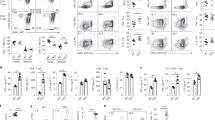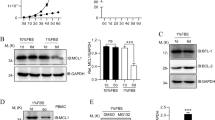Abstract
The active ubiquitin E3 ligase GRAIL is crucial in the induction of CD4 T cell anergy. Here we show that GRAIL is associated with and regulated by two isoforms of the ubiquitin-specific protease otubain 1. In lethally irradiated mice reconstituted with bone marrow cells from T cell receptor–transgenic mice retrovirally transduced to express the genes encoding these proteases, otubain 1–expressing cells contained negligible amounts of endogenous GRAIL, proliferated well and produced large amounts of interleukin 2 after antigenic stimulation. In contrast, cells expressing the alternatively spliced isoform, otubain 1 alternative reading frame 1, contained large amounts of endogenous GRAIL and were functionally anergic, and they proliferated poorly and produced undetectable interleukin 2 when stimulated in a similar way. Thus, these two proteins have opposing epistatic functions in controlling the stability of GRAIL expression and the resultant anergy phenotype in T cells.
This is a preview of subscription content, access via your institution
Access options
Subscribe to this journal
Receive 12 print issues and online access
$209.00 per year
only $17.42 per issue
Buy this article
- Purchase on Springer Link
- Instant access to full article PDF
Prices may be subject to local taxes which are calculated during checkout








Similar content being viewed by others
References
Schwartz, R.H. T cell clonal anergy. Curr. Opin. Immunol. 9, 351–357 (1997).
Quill, H. & Schwartz, R.H. Stimulation of normal inducer T cell clones with antigen presented by purified Ia molecules in planar lipid membranes: specific induction of a long-lived state of proliferative nonresponsiveness. J. Immunol. 138, 3704–3712 (1987).
Anandasabapathy, N. et al. GRAIL: an E3 ubiquitin ligase that inhibits cytokine gene transcription is expressed in anergic CD4+ T cells. Immunity 18, 535–547 (2003).
Pickart, C.M. Ubiquitin in chains. Trends Biochem. Sci. 25, 544–58 (2000).
Hershko, A. & Ciechanover, A. The ubiquitin system. Annu. Rev. Biochem. 67, 425–479 (1998).
Pickart, C.M. Mechanisms underlying ubiquitination. Annu. Rev. Biochem. 70, 503–533 (2001).
Pickart, C.M. Ubiquitin enters the new millennium. Mol. Cell 8, 499–504 (2001).
Krawczyk, C. et al. Cbl-b is a negative regulator of receptor clustering and raft aggregation in T cells. Immunity 13, 463–473 (2000).
Bachmaier, K. et al. Negative regulation of lymphocyte activation and autoimmunity by the molecular adaptor Cbl-b. Nature 403, 211–216 (2000).
Fang, D. et al. Dysregulation of T lymphocyte function in itchy mice: a role for Itch in TH2 differentiation. Nat. Immunol. 3, 281–287 (2002).
Wilkinson, K.D. Regulation of ubiquitin-dependent processes by deubiquitinating enzymes. Faseb J. 11, 1245–1256 (1997).
Li, M. et al. Deubiquitination of p53 by HAUSP is an important pathway for p53 stabilization. Nature 416, 648–653 (2002).
Makarova, K.S., Aravind, L. & Koonin, E.V. A novel superfamily of predicted cysteine proteases from eukaryotes, viruses and Chlamydia pneumoniae . Trends Biochem. Sci. 25, 50–52 (2000).
Balakirev, M.Y., Tcherniuk, S.O., Jaquinod, M. & Chroboczek, J. Otubains: a new family of cysteine proteases in the ubiquitin pathway. EMBO Rep. 4, 517–522 (2003).
Li, T. et al. Identification of two proteins, S14 and UIP1, that interact with UCH37. FEBS Lett 488, 201–205 (2001).
Dove, S.L. & Hochschild, A. Bacterial two-hybrid analysis of interactions between region 4 of the sigma(70) subunit of RNA polymerase and the transcriptional regulators Rsd from Escherichia coli and AlgQ from Pseudomonas aeruginosa . J. Bacteriol. 183, 6413–6421 (2001).
Gnesutta, N. et al. Cloning and characterization of mouse UBPy, a deubiquitinating enzyme that interacts with the ras guanine nucleotide exchange factor CDC25Mm/Ras-GRF1. J. Biol. Chem. 276, 39448–39454 (2001).
Naviglio, S. et al. UBPY: a growth-regulated human ubiquitin isopeptidase. EMBO J. 17, 3241–3250 (1998).
Zhang, Y., Xiong, Y. & Yarbrough, W.G. ARF promotes MDM2 degradation and stabilizes p53: ARF-INK4a locus deletion impairs both the Rb and p53 tumor suppression pathways. Cell 92, 725–734 (1998).
Lam, Y.A., Xu, W., DeMartino, G.N. & Cohen, R.E. Editing of ubiquitin conjugates by an isopeptidase in the 26S proteasome. Nature 385, 737–740 (1997).
Wing, S.S. Deubiquitinating enzymes—the importance of driving in reverse along the ubiquitin-proteasome pathway. Int. J. Biochem. Cell Biol. 35, 590–605 (2003).
Hatakeyama, S. & Nakayama, K.I. U-box proteins as a new family of ubiquitin ligases. Biochem. Biophys. Res. Commun. 302, 635–645 (2003).
Nakajima, A. et al. Antigen-specific T cell-mediated gene therapy in collagen-induced arthritis. J. Clin. Invest. 107, 1293–1301 (2001).
Yang L., Qin, X.F., Baltimore, D. & Van Parijs, L. Generation of functional antigen-specific T cells in defined genetic backgrounds by retrovirus-mediated expression of TCR cDNAs in hematopoietic precursor cells. Proc. Natl. Acad. Sci. USA 99, 6204–6209 (2002).
Acknowledgements
The authors thank J. Bogenberger for discussions; C. Holness and C. Taylor for technical assistance; and R. Kizer for assistance with manuscript preparation. Supported by the National Institute of Allergy and Infectious Diseases (AI-49903-02 to C.G.F. and AI01731-03 to C.M.S), and the National Cancer Institute (CA65237-14 to C.G.F., CA85774 to L.S. and E.E. and 5T32 AI07290-18 to C.D.C.).
Author information
Authors and Affiliations
Corresponding author
Ethics declarations
Competing interests
The authors declare no competing financial interests.
Supplementary information
Rights and permissions
About this article
Cite this article
Soares, L., Seroogy, C., Skrenta, H. et al. Two isoforms of otubain 1 regulate T cell anergy via GRAIL. Nat Immunol 5, 45–54 (2004). https://doi.org/10.1038/ni1017
Received:
Accepted:
Published:
Issue Date:
DOI: https://doi.org/10.1038/ni1017
This article is cited by
-
Partial otubain 1 deficiency compromises fetal well-being in allogeneic pregnancies despite no major changes in the dendritic cell and T cell compartment
BMC Research Notes (2022)
-
The function and regulation of OTU deubiquitinases
Frontiers of Medicine (2020)
-
The role of ubiquitin-specific peptidases in cancer progression
Journal of Biomedical Science (2019)
-
Fine-tuning of thymocyte development by ubiquitination-mediated stability control of the ESCRT protein CHMP5
Cellular & Molecular Immunology (2017)
-
The ubiquitin-specific protease USP8 is critical for the development and homeostasis of T cells
Nature Immunology (2015)



